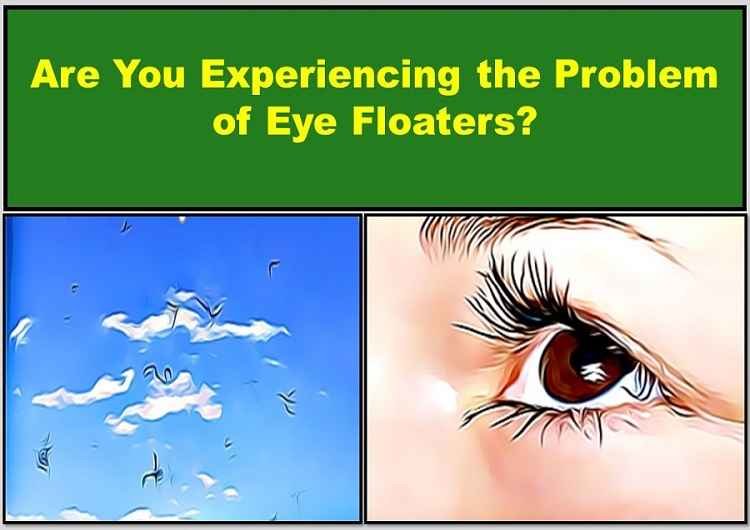Seeing squiggly lines in peripheral vision? Seeing wavy lines in corner of the eye? What are these zig-zag lines in eyesight? Today’s topic is all about these Squiggly Lines in Vision (Eye Floaters) or wavy lines in Vision: Introduction, Symptoms, Causes, Prevention, Diagnosis, Complications, and Treatment.
What are Wavy Squiggly Lines in Vision or Eye Floaters?
Eye floaters are very small spots, rings, or specks of different shapes and sizes floating in your eyes, which you can notice in your field of vision.
Eye floaters are clearly seen as moving spots or wavy lines, squiggly lines when you look at the bright or shiny backgrounds like screen, book, or sky.
Those spots, specks, or wavy lines in vision are not present on the surface of your eyes, but are inside the eyeball, especially in the vitreous humor.
The vitreous humor is a transparent jelly-like substance present between the retina and the lens of the eye.
The retina is a thin film present in the posterior wall of the eye. This retina contains special cells called rods and cones which help you to see and understand different colors, shapes, and patterns.
The lens of your eye focuses the light on the retina and then the rods and cones send signals to your brain, then the brain interprets it and tells you what you are seeing.
Since the squiggly lines or floating spots are present in the vitreous humor, they appear as shadows in your field of vision.

Symptoms of Eye Floaters or Wavy Lines in Vision
Eye floaters can be of different shapes and sizes such as:
- Dots or spots like
- Thread shape or wavy, squiggly lines in vision (eyesight)
- Bubble shaped
- Spider web pattern
- Zigzag lines
Eye floaters can be peripheral (on the sides) or in the center of your visual field. When you roll your eyes or try to see those spots or shadows, the squiggly lines in the eyes usually move away or are not visible. Otherwise, they float repeatedly in front of your eyes.
Eye Floaters Causes (Causes of Squiggly lines in vision)
Eye floaters can be seen as a normal, natural phenomenon that occurs with a person’s age. The reason for this is that the vitreous humor gradually deforms with age and also detaches from the retina.
However, the problem of spots, squiggly, wavy lines in vision or eyesight can also be caused by the following conditions:
- Bleeding inside the eyes
- Eye injury or eye infection
- Posterior uveitis: Inflammation (swelling and irritation) in the uvea (uvea is a middle layer of the eyeball, just below the sclera).
- Vitreous detachment
- Retinal detachment
- Side effects of medicines associated with the eyes
- Eye floaters can also occur for no apparent reason.
Prevention
Although it is not possible to completely stop the eye floaters, you can reduce the risk of developing these squiggling lines by maintaining good eye health. The following eye health tips might help you with it.
- Eat a healthy and balanced diet and regularly incorporate physical activity into your daily routine to stay fit
- Get your eyes checked regularly
- Do not put too much pressure or stress on your eyes
- Quit smoking
- If you have to spend too much time in front of the screen every day, strictly follow the 20-20-20 rule. Focus on something at a distance of 20 feet for 20 seconds after every 20 minutes of screen use. This also helps to minimize the effect of Computer Vision Syndrome.
- Whenever you go out of the house, make sure to wear sunglasses to keep your eyes protected from the harmful UV rays of the sun.
- Wash and clean your hands thoroughly before applying or removing contact lenses. This habit also reduces the risk of eye infection
Diagnosis
The floaters of constant shape, size, and number for a longer time without any visual changes is a normal aging process. You should not be worried about it at all. However, you should see a doctor if you are experiencing any of the following signs and symptoms.
- Eye pain
- Blurry vision
- Double vision
- Large Shadow or dark curtain or spots in the field of vision
- Increase in shape, size, and number of eye floaters
Your doctor will do a thorough examination of your eyes to identify any underlying condition, especially the retina and vitreous humor, to determine if there is any damage or any other problem to your retina. Apart from this, the doctor may also ask you some questions to evaluate your condition:
· How long have floaters been in your eyes or visual field?
· Do you have diabetes, autoimmune disease, or other systemic illness?
· Is the problem of floaters much worse in one eye?
· Have you recently had eye surgery?
· Have you suffered any kind of injury or shock to the eye?
· Do you see a curtain in front of your vision?
If you have a problem with floaters, get your eyes checked regularly by the eye doctors, so that the doctor can monitor your eye condition. Your doctor can start the proper treatment immediately if there is any sign of risk to your eyes.
Risk and complications associated with squiggly lines in eyesight
There are also some risk factors associated with the problem of eye floaters or vision spots, which can cause this problem:
- Diabetes
- Increasing age (over 50 years)
- High Myopia
- Cataract surgery
- Ocular trauma
Eye floaters Treatment: How to treat wavy lines in vision?
Eye floaters or squiggly lines on the visual field occur as a normal aging process in most people. You do not need any treatment if you are not having any vision-related problems. But if the floater is due to an ill-health condition like diabetes, eye inflammation, then your doctor will first treat the cause, which is causing the floaters.
Vitrectomy eye surgery is recommended if the patient is having vision problems due to eye floaters and affecting day-to-day activities.
In this surgical procedure, surgeons remove the vitreous humor and replace it with another fluid, such as silicone oil.
However, surgery carries a lot of risks, including increased development of vision defects such as refractive errors (myopia, hypermetropia, or astigmatism), cataracts, and retinal detachments.
Sometimes a laser treatment, called vitreolysis, is also used to reduce the size of the floaters or to remove them completely. This process is completed in 2 to 3 sittings and each sitting takes about 1 hour. Vitreolysis laser treatment also has some side effects such as increased eye pressure (IOP) and cataracts.
You should talk to your eye doctor about the risks and benefits of vitrectomy surgery and vitreolysis laser treatment before undergoing any of these procedures.

